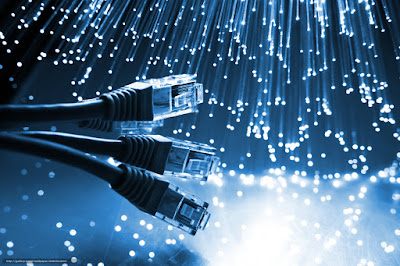Today there are so many wireless networking. We can find Wi Fi everywhere, in your house, office, restaurant, shopping mall, and many else. But that doesn't mean that there are no networking cables anymore. As summarized from lifewire.com, today's computer still rely on cable in order to connect to the internet. There are several types of network cables, each with their advantages and purposes.
1. Coaxial Cables
In the first list is the old coaxial cable. Why old? Because it was invented in 1880's. "coax" was best known as the kind of cable that connected television
sets to home antennas. Coaxial cable is also a standard for 10 Mbps Ethernet cables.
When 10 Mbps Ethernet was most popular, during the 1980s and early
1990s, networks typically utilized one of two kinds of coax cable - thinnet (10BASE2 standard) or thicknet
(10BASE5). These cables consist of an inner copper wire of varying
thickness surrounded by insulation and other shielding. Their stiffness
caused network administrators difficulty in installing and maintaining
thinnet and thicknet.
2. Twisted Pair Cables
Twisted Pair was invented in 1990's as the leading cabling standard for Ethernet, starting with 10 Mbps (10BASE-T, also known as Category 3 or Cat3), later followed by improved versions for 100 Mbps (100BASE-TX, Cat5 and Cat5e)
and successively higher speeds up to 10 Gbps (10GBASE-T).
Twisted pair cabling is a form of wiring in which pairs of wires (the forward and return conductors of a single circuit) are twisted together for the purposes of canceling out electromagnetic interference (EMI) from other wire pairs and from external sources. This type of cable is used for home and corporate Ethernet networks. Twisted pair cabling is used in short patch cables and in the longer runs in structured cabling.
An Ethernet crossover cable
is a type of twisted pair Ethernet cable used to connect computing
devices together directly that would normally be connected via a network switch, hub or router, such as directly connecting two personal computers via their network adapters. Most current Ethernet devices support Auto MDI-X, so it doesn't matter whether you use crossover or straight cables.
3. Fiber Optics
An optical fiber cable
consists of a center glass core surrounded by several layers of
protective material. The outer insulating jacket is made of Teflon or
PVC to prevent interference. Optical fiber deployment is more expensive
than copper but offers higher bandwidth and can cover longer distances.
These network cables are bendable despite being made of glass. They have proven especially useful in wide area network (WAN)
installations where long distance underground or outdoor cable runs are
required and also in office buildings where a high volume of
communication traffic is common.
Two primary types of fiber optic cable industry standards are defined – single-mode (100BaseBX standard) and multimode (100BaseSX standard). Long-distance telecommunications networks more commonly use single-mode for its relatively higher bandwidth capacity, while local networks typically use multimode instead due to its lower cost.
There are two major types of optical fiber cables: short-range multi-mode fiber and long-range single-mode fiber.
Read Also: Type Of Network And It's Explanation
4. USB Cables
Most Universal Serial Bus (USB) cables connect a computer with a peripheral device (keyboard or mouse) rather than to another computer. However, special network adapters (sometimes called dongles) also allow connecting an Ethernet cable to a USB port indirectly. USB cables feature twisted-pair wiring.
5. Crossover Cables
Null modem cables are one example of the category of crossover cables. A crossover cable joins two network devices of the same type, such as two PCs or two network switches.
The
use of Ethernet crossover cables was especially common on older home
networks years ago when connecting two PCs directly together.
Externally, Ethernet crossover cables appear nearly identical to
ordinary (sometimes also called straight-through), the only
visible difference being the order of color-coded wires appearing on the
cable's end connector. Manufacturers typically applied special
distinguishing marks to their crossover cables for this reason.
Nowadays, though, most home networks utilize routers that have built-in
crossover capability, eliminating the need for these special cables.
6. Patch
A patch cable is an electrical or optical cable used to connect one electronic or optical device to another or to building infrastructure for signal
routing. Devices of different types (e.g. a switch connected to a
computer, or a switch connected to a router) are connected with patch
cords. Patch cords are usually produced in many different colors so as
to be easily distinguishable, and most are relatively short, no longer than a few meters. In contrast to on-premises wiring, patch cables are more flexible but may also be less durable.
7. Power lines
Although power wires are not designed for networking applications, new technologies like Power line communication
allows these wires to also be used to interconnect home computers,
peripherals or other networked consumer products. On December 2008, the ITU-T adopted Recommendation G.hn/G.9960 as the first worldwide standard for high-speed powerline communications. G.hn also specifies communications over phonelines and coaxial wiring.
Cables are the most important thing in our life, without cables. We can't connect to the internet and without cables, there will be no wireless networking. Well, That's all type of network cables. Hope you liked it and stay tuned if you want to read the next article.











This post is very informative. Ethernet cables come in a variety of sizes and shapes to meet the needs of different applications. They are typically used to connect devices together, such as computers or networking equipment, but can also be used for other purposes, such as connecting power outlets.
ReplyDeleteEthernet Network Cables